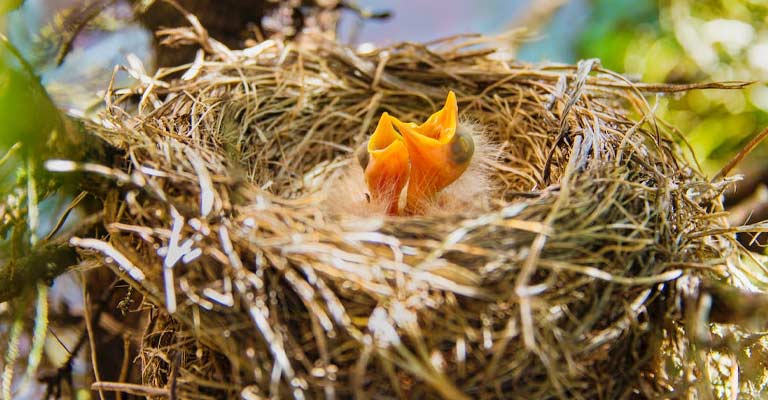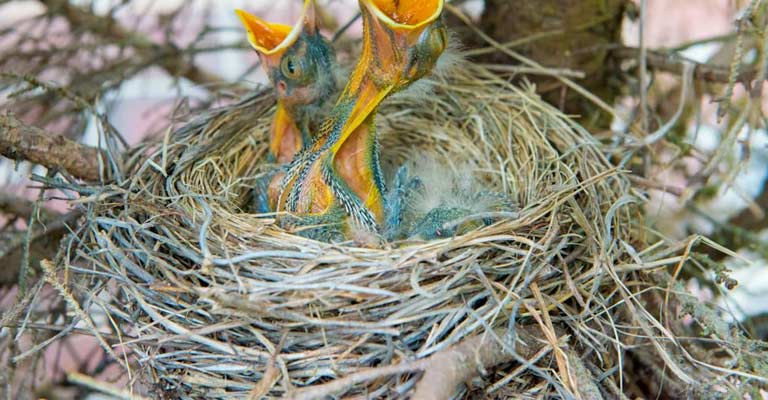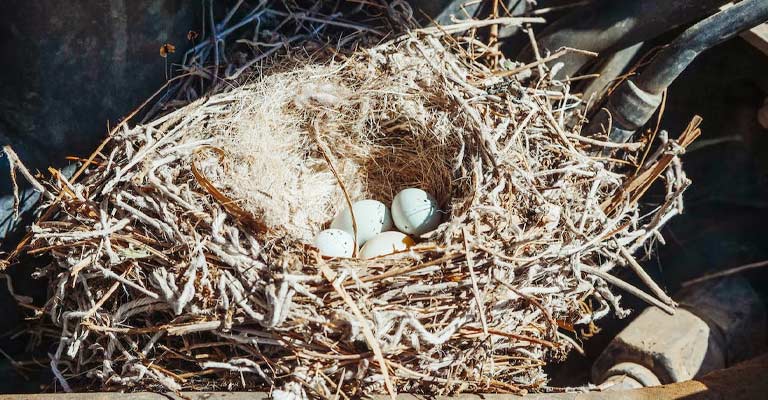The intricate process of avian nesting begins with the strategic selection of a nesting site, a decision driven by a complex interplay of environmental factors crucial for the survival of both parent birds and their offspring.
From the sheltered heights of trees to the concealed recesses of urban structures, the choices birds make in determining their nesting location reflect their innate instincts and adaptations to the diverse landscapes they inhabit.
Understanding how birds choose where to nest unveils a captivating narrative of avian behavior, exploring the delicate balance between the quest for safety, access to resources, and the optimization of environmental conditions for successful reproduction.

How Do Birds Choose Where To Nest?
Here’s how birds choose where to nest:
Shelter and Concealment
Birds prioritize locations that offer shelter and concealment to protect their nests from predators and adverse weather conditions. Trees, shrubs, and dense vegetation provide an ideal cover, ensuring the safety and security of their nesting sites.
Proximity to Food Sources
Access to food is a crucial factor in nest site selection. Birds often choose locations close to abundant food sources, ensuring a convenient supply for both adults and chicks. Proximity to diverse food options contributes to the overall reproductive success of the nesting pair.
Nesting Material Availability
The availability of suitable nesting materials influences the choice of nesting sites. Birds select areas where materials like twigs, leaves, feathers, and other components necessary for nest construction are readily accessible, streamlining the building process.
Temperature Regulation
Birds carefully choose nest locations based on temperature regulation. Depending on the species, they may select areas with optimal sunlight exposure for warmth or shade for cooling, ensuring a favorable microclimate for incubating eggs and raising chicks.
Predator Avoidance
Minimizing the risk of predation is a paramount consideration. Birds often opt for elevated locations that provide a vantage point to detect predators and reduce the likelihood of successful attacks. Strategic nesting in hidden or less accessible spots helps enhance nest security.
Social Structure and Competition
In species with social structures, such as colonial nesters, birds may choose locations based on interactions with conspecifics.
Maintaining an appropriate distance from neighboring nests reduces competition for resources and minimizes potential conflicts, fostering a more conducive environment for successful reproduction.
Accessibility and Flight Paths
The accessibility of the nest site and flight paths to and from the nest are crucial considerations. Birds choose locations that allow for easy ingress and egress, facilitating efficient foraging and reducing the risk of collisions with obstacles during flight.
Birds employ a multifaceted approach when choosing where to nest, considering factors such as shelter, food proximity, nesting material availability, temperature regulation, predator avoidance, social dynamics, and accessibility to create optimal conditions for successful reproduction.
What Are Some Best Places For Birds To Nest?

Here are some best places for birds to nest:
Trees and Shrubs
Trees and shrubs are among the best natural nesting sites for birds. They provide excellent cover, protection from predators, and a stable structure for building nests.
Different species may favor specific types of trees or shrubs depending on height, density, and foliage.
Cliffs and Rock Ledges
Cliff faces and rock ledges offer secure nesting sites, particularly for birds that prefer elevated locations. Nesting on cliffs provides birds with a strategic advantage against ground predators and may facilitate efficient takeoffs and landings.
Man-Made Birdhouses
Specifically designed birdhouses or nest boxes provided by humans offer a safe and protected environment for many bird species. These structures mimic natural nesting conditions and are strategically placed in gardens, parks, or backyards to encourage avian habitation.
Cavities in Trees
Natural tree cavities or holes created by decay or woodpeckers serve as ideal nesting sites for cavity-nesting birds. These locations provide a concealed and sheltered space, protecting nests from the elements and potential predators.
Reeds and Grasses
Wetland areas with dense reeds and grasses provide suitable nesting sites for waterfowl and marsh-dwelling birds. The tall vegetation offers both concealment and structural support for nests, creating a secure environment for raising chicks.
Clumps of Vegetation
Birds often choose dense clumps of vegetation, such as thickets or bushes, for nesting. These areas provide ample cover and protection, making it challenging for ground predators to access nests. The vegetation also contributes to the stability of the nesting structure.
Building Eaves and Ledges
Urban environments with buildings and structures featuring eaves, ledges, or overhangs can attract nesting birds. These elevated spaces provide protection and mimic natural cliff environments.
Certain bird species, such as pigeons and swallows, readily adapt to these man-made nesting opportunities.
The best places for birds to nest encompass a variety of natural and artificial locations that offer shelter, protection, and proximity to essential resources.
Trees, cliffs, birdhouses, tree cavities, wetland vegetation, thickets, and building structures with suitable ledges all contribute to the diverse and strategic choices birds make for creating secure nesting environments.
How Does A Bird Nest Come About?

Let’s discuss how a bird nest comes about:
Selection of Nest Site
The process of bird nest formation begins with the selection of a suitable nesting site. Factors such as shelter, protection from predators, and proximity to food sources influence this choice.
Birds may use existing structures, like trees or cliffs, or create nests in specialized locations, such as birdhouses or man-made ledges.
Gathering Nesting Materials
Once a site is chosen, birds embark on the gathering phase, collecting materials for nest construction. These materials vary among species and may include twigs, leaves, grass, feathers, and even man-made items like paper or string.
The collection process demonstrates the bird’s resourcefulness and adaptation to the available materials in their environment.
Nest Construction
With a cache of materials, birds meticulously construct their nests. This phase involves weaving and arranging collected items into a secure and stable structure.
The construction process showcases the bird’s instinctive knowledge of nest architecture, ensuring the creation of a safe haven for eggs and chicks.
Laying of Eggs
Once the nest is complete, the female bird lays eggs within the structure. The number of eggs varies by species, and the size and shape of the nest are adapted to accommodate and protect the eggs during incubation. The careful placement of eggs is a critical step in the reproductive cycle.
Incubation Period
The female bird assumes the responsibility of incubating the eggs and maintaining a consistent temperature for proper development.
The incubation period is a crucial stage in the nesting process, during which the parent ensures the eggs receive the warmth and protection needed for successful hatching.
Chick Rearing
Upon hatching, the parents continue their care by feeding and nurturing the chicks. The provision of food, protection, and warmth is essential during this phase.
Nestlings rely entirely on their parents for survival, and the nest becomes a hub for their growth and development.
Fledging and Nest Departure
As the chicks mature, they reach a stage where they are ready to leave the nest. This process, known as fledging, marks the end of the nesting cycle. Chicks may fledge gradually or all at once, depending on the species.
After fledging, young birds gradually become independent, and the nest is abandoned.
The formation of a bird nest involves a series of intricately orchestrated steps, from site selection and material gathering to construction, egg laying, incubation, chick rearing, and eventual fledging. This remarkable process showcases the innate behaviors and adaptations that ensure the survival and continuity of avian species.
FAQs
How do birds decide where to build nests?
Birds choose nesting sites based on a combination of factors like shelter, protection from predators, and proximity to food sources. Environmental cues, such as vegetation density and temperature regulation, also influence their decisions.
What influences a bird’s choice of nesting material?
The availability of nesting materials in the environment guides a bird’s choice. Twigs, leaves, feathers, and even man-made items are selected based on accessibility and suitability for constructing a stable nest.
Do birds prefer natural or man-made nesting sites?
Birds exhibit adaptability, using both natural structures like trees and cliffs and man-made sites such as birdhouses or ledges. The choice depends on the species and the specific environmental conditions.
How do birds know when to lay eggs in the nest?
The timing of egg-laying is often influenced by seasonal and environmental cues. Birds instinctively recognize optimal conditions, including temperature and food availability, signaling the readiness to lay eggs.
What happens after the chicks fledge?
Once the chicks fledge or leave the nest, the parenting phase transitions. The fledglings gradually become independent, relying less on parental care, and the nest is abandoned as the birds continue their life cycle.
Conclusion
In the fascinating world of avian ecology, the journey of how birds choose where to nest is a testament to the remarkable adaptability and resourcefulness ingrained in their instincts.
From the meticulous selection of materials to the construction of intricate nests, birds demonstrate an innate understanding of their surroundings.
The diverse choices, whether in natural habitats or urban environments, underscore the resilience of birds in navigating the challenges of their ecosystems.
Appreciating the intricacies of avian nesting provides a profound glimpse into the delicate yet robust strategies that ensure the continuity of bird species across diverse landscapes.